Motivation and Leadership Strategies: A Case Study Analysis
VerifiedAdded on 2022/08/16
|21
|6302
|350
Essay
AI Summary
This essay delves into the critical role of motivation and leadership within organizations, focusing on strategies to reduce employee turnover. The author examines the case of Mr. Simon, a demotivated employee in a retail setting, and explores various motivational theories, including Skinner's operant conditioning, Daniel Katz's functionalist theory, and Albert Bandura's social learning theory, to understand the factors influencing employee attitudes and commitment. The essay further analyzes Herzberg's two-factor theory and McGregor's Theory X and Theory Y, offering insights into hygiene and motivational factors, as well as different management styles. It emphasizes the importance of team building, effective communication, and clear goals in fostering a positive work environment and enhancing employee performance. The essay concludes by highlighting the significance of applying these motivational theories and team-building processes to retain valuable employees and achieve organizational goals.
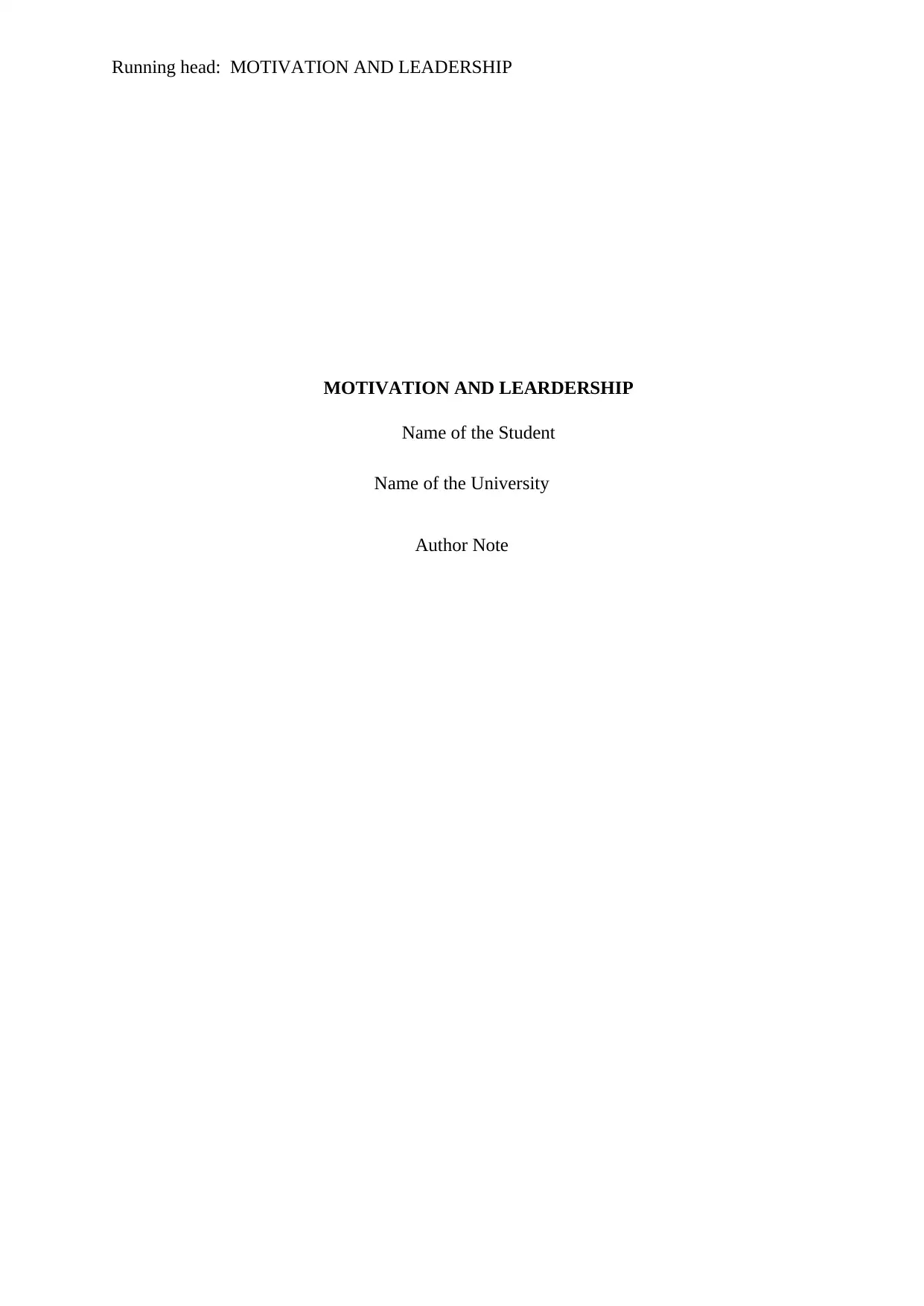
Running head: MOTIVATION AND LEADERSHIP
MOTIVATION AND LEARDERSHIP
Name of the Student
Name of the University
Author Note
MOTIVATION AND LEARDERSHIP
Name of the Student
Name of the University
Author Note
Paraphrase This Document
Need a fresh take? Get an instant paraphrase of this document with our AI Paraphraser
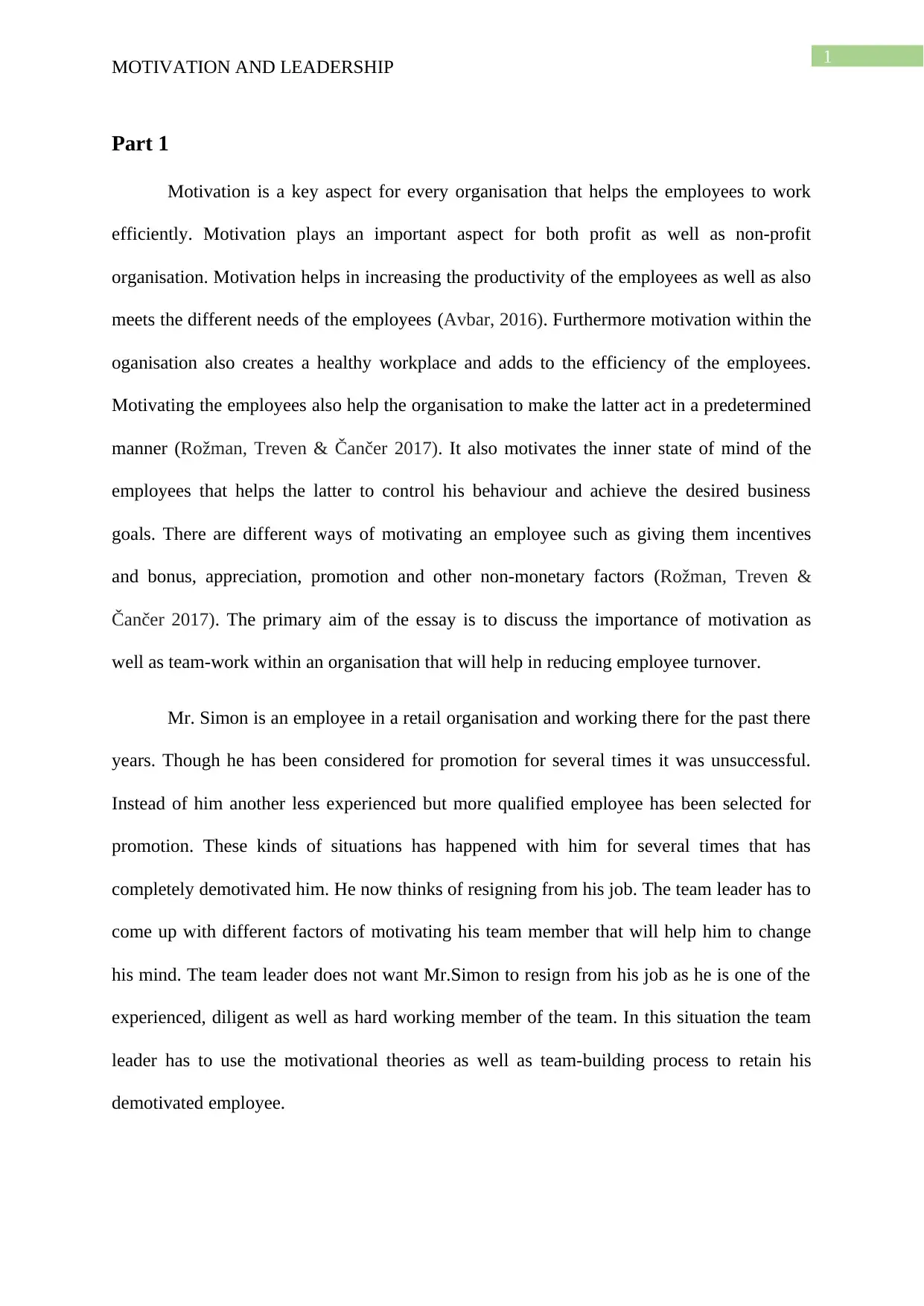
1
MOTIVATION AND LEADERSHIP
Part 1
Motivation is a key aspect for every organisation that helps the employees to work
efficiently. Motivation plays an important aspect for both profit as well as non-profit
organisation. Motivation helps in increasing the productivity of the employees as well as also
meets the different needs of the employees (Avbar, 2016). Furthermore motivation within the
oganisation also creates a healthy workplace and adds to the efficiency of the employees.
Motivating the employees also help the organisation to make the latter act in a predetermined
manner (Rožman, Treven & Čančer 2017). It also motivates the inner state of mind of the
employees that helps the latter to control his behaviour and achieve the desired business
goals. There are different ways of motivating an employee such as giving them incentives
and bonus, appreciation, promotion and other non-monetary factors (Rožman, Treven &
Čančer 2017). The primary aim of the essay is to discuss the importance of motivation as
well as team-work within an organisation that will help in reducing employee turnover.
Mr. Simon is an employee in a retail organisation and working there for the past there
years. Though he has been considered for promotion for several times it was unsuccessful.
Instead of him another less experienced but more qualified employee has been selected for
promotion. These kinds of situations has happened with him for several times that has
completely demotivated him. He now thinks of resigning from his job. The team leader has to
come up with different factors of motivating his team member that will help him to change
his mind. The team leader does not want Mr.Simon to resign from his job as he is one of the
experienced, diligent as well as hard working member of the team. In this situation the team
leader has to use the motivational theories as well as team-building process to retain his
demotivated employee.
MOTIVATION AND LEADERSHIP
Part 1
Motivation is a key aspect for every organisation that helps the employees to work
efficiently. Motivation plays an important aspect for both profit as well as non-profit
organisation. Motivation helps in increasing the productivity of the employees as well as also
meets the different needs of the employees (Avbar, 2016). Furthermore motivation within the
oganisation also creates a healthy workplace and adds to the efficiency of the employees.
Motivating the employees also help the organisation to make the latter act in a predetermined
manner (Rožman, Treven & Čančer 2017). It also motivates the inner state of mind of the
employees that helps the latter to control his behaviour and achieve the desired business
goals. There are different ways of motivating an employee such as giving them incentives
and bonus, appreciation, promotion and other non-monetary factors (Rožman, Treven &
Čančer 2017). The primary aim of the essay is to discuss the importance of motivation as
well as team-work within an organisation that will help in reducing employee turnover.
Mr. Simon is an employee in a retail organisation and working there for the past there
years. Though he has been considered for promotion for several times it was unsuccessful.
Instead of him another less experienced but more qualified employee has been selected for
promotion. These kinds of situations has happened with him for several times that has
completely demotivated him. He now thinks of resigning from his job. The team leader has to
come up with different factors of motivating his team member that will help him to change
his mind. The team leader does not want Mr.Simon to resign from his job as he is one of the
experienced, diligent as well as hard working member of the team. In this situation the team
leader has to use the motivational theories as well as team-building process to retain his
demotivated employee.
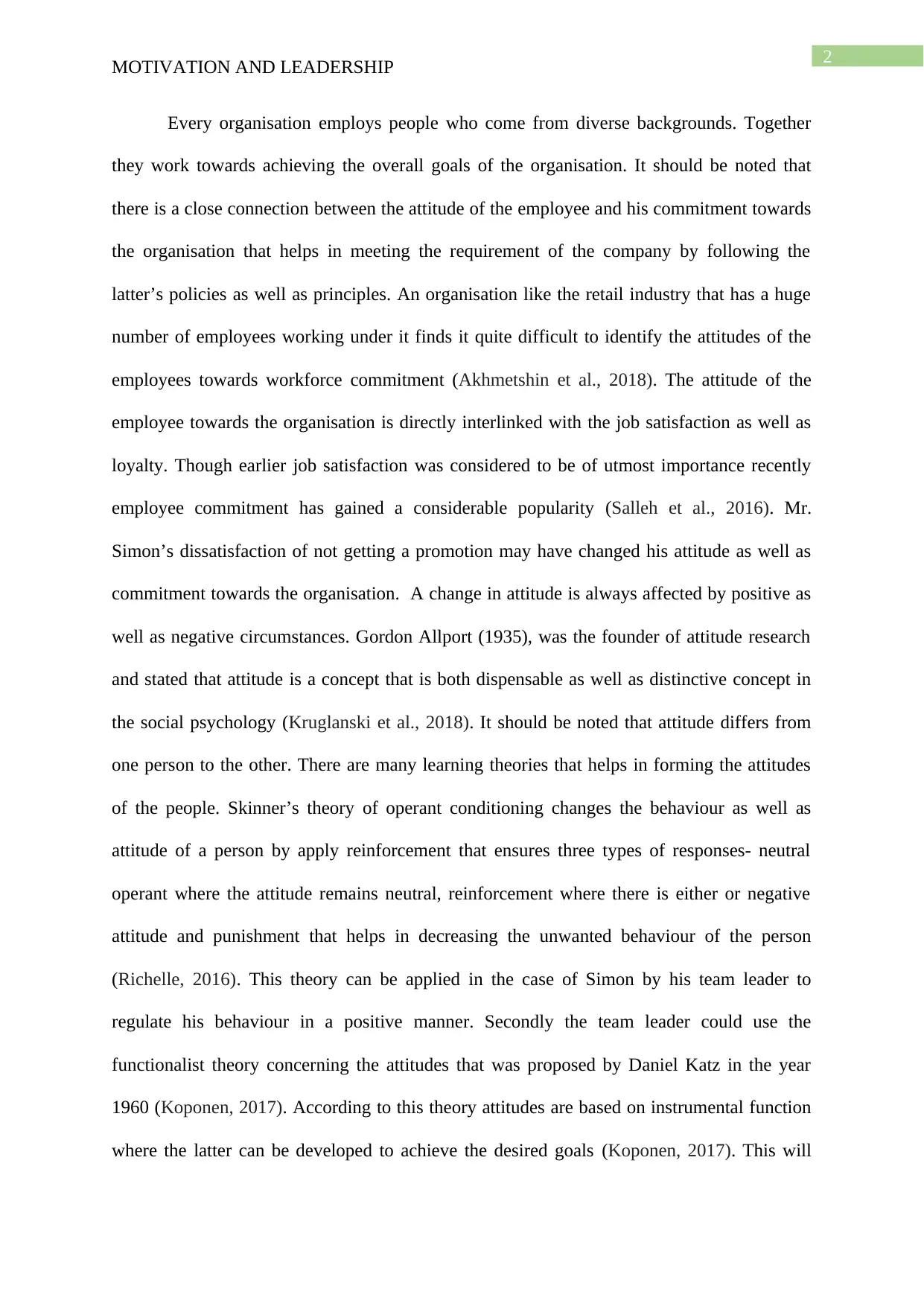
2
MOTIVATION AND LEADERSHIP
Every organisation employs people who come from diverse backgrounds. Together
they work towards achieving the overall goals of the organisation. It should be noted that
there is a close connection between the attitude of the employee and his commitment towards
the organisation that helps in meeting the requirement of the company by following the
latter’s policies as well as principles. An organisation like the retail industry that has a huge
number of employees working under it finds it quite difficult to identify the attitudes of the
employees towards workforce commitment (Akhmetshin et al., 2018). The attitude of the
employee towards the organisation is directly interlinked with the job satisfaction as well as
loyalty. Though earlier job satisfaction was considered to be of utmost importance recently
employee commitment has gained a considerable popularity (Salleh et al., 2016). Mr.
Simon’s dissatisfaction of not getting a promotion may have changed his attitude as well as
commitment towards the organisation. A change in attitude is always affected by positive as
well as negative circumstances. Gordon Allport (1935), was the founder of attitude research
and stated that attitude is a concept that is both dispensable as well as distinctive concept in
the social psychology (Kruglanski et al., 2018). It should be noted that attitude differs from
one person to the other. There are many learning theories that helps in forming the attitudes
of the people. Skinner’s theory of operant conditioning changes the behaviour as well as
attitude of a person by apply reinforcement that ensures three types of responses- neutral
operant where the attitude remains neutral, reinforcement where there is either or negative
attitude and punishment that helps in decreasing the unwanted behaviour of the person
(Richelle, 2016). This theory can be applied in the case of Simon by his team leader to
regulate his behaviour in a positive manner. Secondly the team leader could use the
functionalist theory concerning the attitudes that was proposed by Daniel Katz in the year
1960 (Koponen, 2017). According to this theory attitudes are based on instrumental function
where the latter can be developed to achieve the desired goals (Koponen, 2017). This will
MOTIVATION AND LEADERSHIP
Every organisation employs people who come from diverse backgrounds. Together
they work towards achieving the overall goals of the organisation. It should be noted that
there is a close connection between the attitude of the employee and his commitment towards
the organisation that helps in meeting the requirement of the company by following the
latter’s policies as well as principles. An organisation like the retail industry that has a huge
number of employees working under it finds it quite difficult to identify the attitudes of the
employees towards workforce commitment (Akhmetshin et al., 2018). The attitude of the
employee towards the organisation is directly interlinked with the job satisfaction as well as
loyalty. Though earlier job satisfaction was considered to be of utmost importance recently
employee commitment has gained a considerable popularity (Salleh et al., 2016). Mr.
Simon’s dissatisfaction of not getting a promotion may have changed his attitude as well as
commitment towards the organisation. A change in attitude is always affected by positive as
well as negative circumstances. Gordon Allport (1935), was the founder of attitude research
and stated that attitude is a concept that is both dispensable as well as distinctive concept in
the social psychology (Kruglanski et al., 2018). It should be noted that attitude differs from
one person to the other. There are many learning theories that helps in forming the attitudes
of the people. Skinner’s theory of operant conditioning changes the behaviour as well as
attitude of a person by apply reinforcement that ensures three types of responses- neutral
operant where the attitude remains neutral, reinforcement where there is either or negative
attitude and punishment that helps in decreasing the unwanted behaviour of the person
(Richelle, 2016). This theory can be applied in the case of Simon by his team leader to
regulate his behaviour in a positive manner. Secondly the team leader could use the
functionalist theory concerning the attitudes that was proposed by Daniel Katz in the year
1960 (Koponen, 2017). According to this theory attitudes are based on instrumental function
where the latter can be developed to achieve the desired goals (Koponen, 2017). This will
⊘ This is a preview!⊘
Do you want full access?
Subscribe today to unlock all pages.

Trusted by 1+ million students worldwide
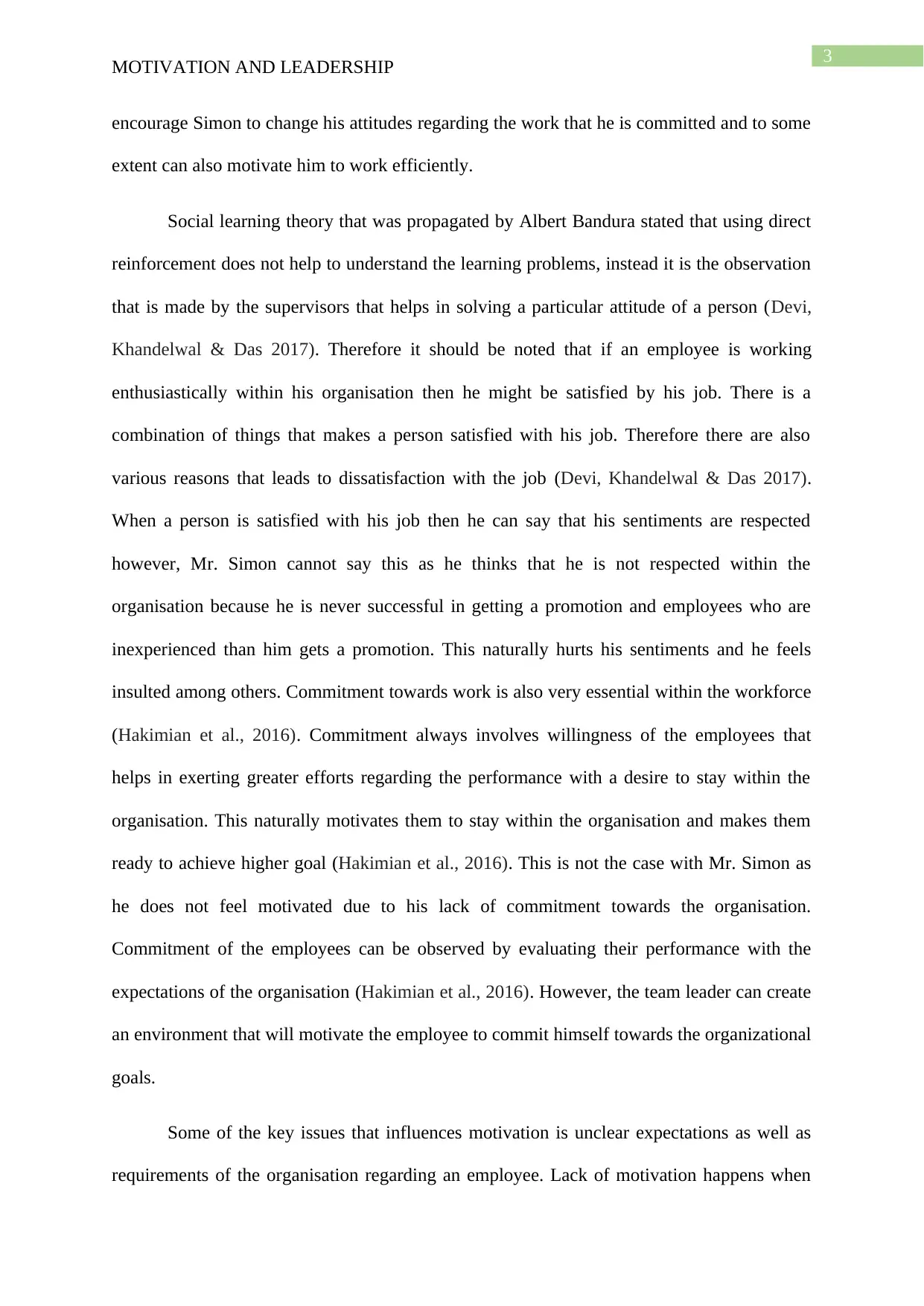
3
MOTIVATION AND LEADERSHIP
encourage Simon to change his attitudes regarding the work that he is committed and to some
extent can also motivate him to work efficiently.
Social learning theory that was propagated by Albert Bandura stated that using direct
reinforcement does not help to understand the learning problems, instead it is the observation
that is made by the supervisors that helps in solving a particular attitude of a person (Devi,
Khandelwal & Das 2017). Therefore it should be noted that if an employee is working
enthusiastically within his organisation then he might be satisfied by his job. There is a
combination of things that makes a person satisfied with his job. Therefore there are also
various reasons that leads to dissatisfaction with the job (Devi, Khandelwal & Das 2017).
When a person is satisfied with his job then he can say that his sentiments are respected
however, Mr. Simon cannot say this as he thinks that he is not respected within the
organisation because he is never successful in getting a promotion and employees who are
inexperienced than him gets a promotion. This naturally hurts his sentiments and he feels
insulted among others. Commitment towards work is also very essential within the workforce
(Hakimian et al., 2016). Commitment always involves willingness of the employees that
helps in exerting greater efforts regarding the performance with a desire to stay within the
organisation. This naturally motivates them to stay within the organisation and makes them
ready to achieve higher goal (Hakimian et al., 2016). This is not the case with Mr. Simon as
he does not feel motivated due to his lack of commitment towards the organisation.
Commitment of the employees can be observed by evaluating their performance with the
expectations of the organisation (Hakimian et al., 2016). However, the team leader can create
an environment that will motivate the employee to commit himself towards the organizational
goals.
Some of the key issues that influences motivation is unclear expectations as well as
requirements of the organisation regarding an employee. Lack of motivation happens when
MOTIVATION AND LEADERSHIP
encourage Simon to change his attitudes regarding the work that he is committed and to some
extent can also motivate him to work efficiently.
Social learning theory that was propagated by Albert Bandura stated that using direct
reinforcement does not help to understand the learning problems, instead it is the observation
that is made by the supervisors that helps in solving a particular attitude of a person (Devi,
Khandelwal & Das 2017). Therefore it should be noted that if an employee is working
enthusiastically within his organisation then he might be satisfied by his job. There is a
combination of things that makes a person satisfied with his job. Therefore there are also
various reasons that leads to dissatisfaction with the job (Devi, Khandelwal & Das 2017).
When a person is satisfied with his job then he can say that his sentiments are respected
however, Mr. Simon cannot say this as he thinks that he is not respected within the
organisation because he is never successful in getting a promotion and employees who are
inexperienced than him gets a promotion. This naturally hurts his sentiments and he feels
insulted among others. Commitment towards work is also very essential within the workforce
(Hakimian et al., 2016). Commitment always involves willingness of the employees that
helps in exerting greater efforts regarding the performance with a desire to stay within the
organisation. This naturally motivates them to stay within the organisation and makes them
ready to achieve higher goal (Hakimian et al., 2016). This is not the case with Mr. Simon as
he does not feel motivated due to his lack of commitment towards the organisation.
Commitment of the employees can be observed by evaluating their performance with the
expectations of the organisation (Hakimian et al., 2016). However, the team leader can create
an environment that will motivate the employee to commit himself towards the organizational
goals.
Some of the key issues that influences motivation is unclear expectations as well as
requirements of the organisation regarding an employee. Lack of motivation happens when
Paraphrase This Document
Need a fresh take? Get an instant paraphrase of this document with our AI Paraphraser
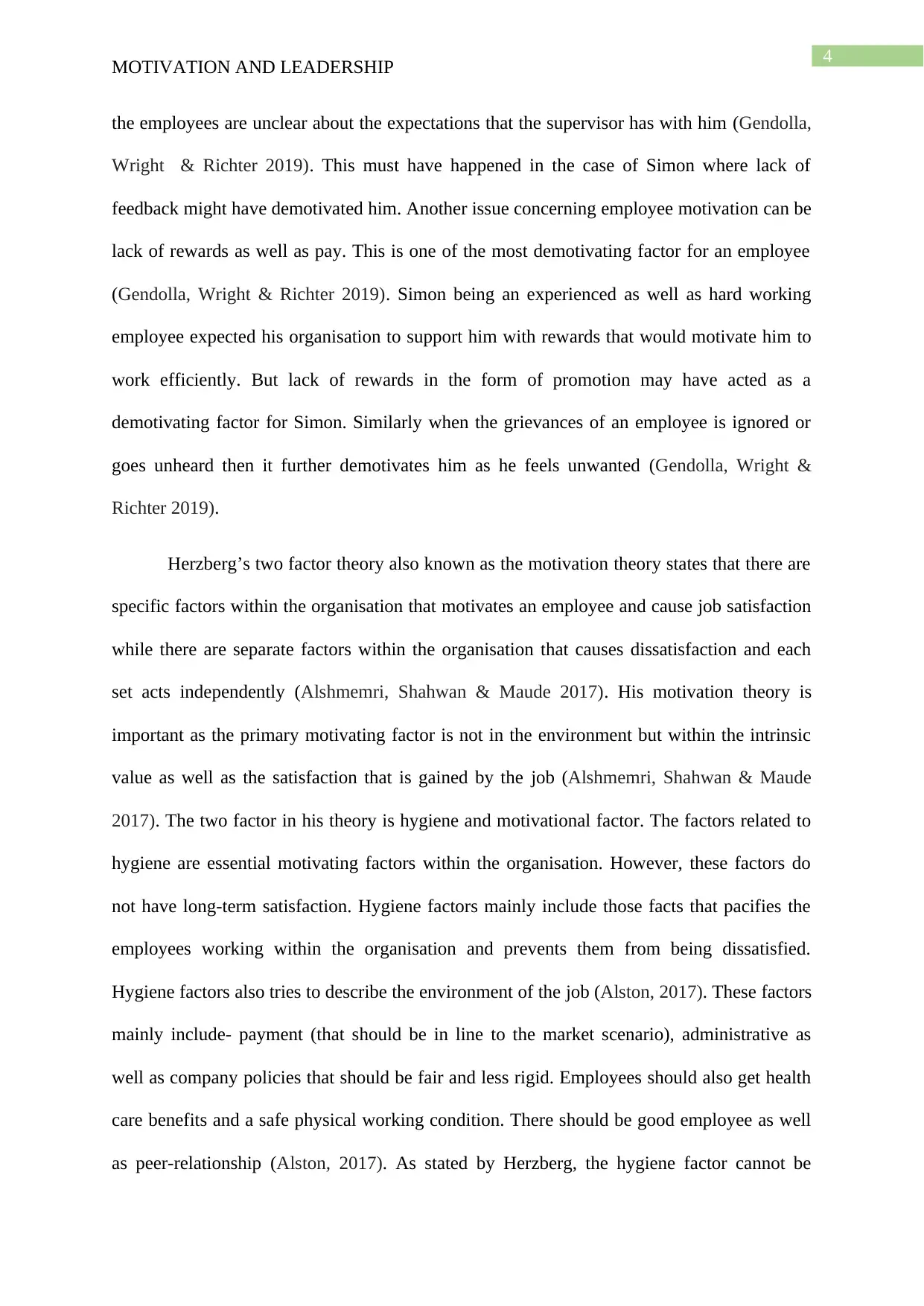
4
MOTIVATION AND LEADERSHIP
the employees are unclear about the expectations that the supervisor has with him (Gendolla,
Wright & Richter 2019). This must have happened in the case of Simon where lack of
feedback might have demotivated him. Another issue concerning employee motivation can be
lack of rewards as well as pay. This is one of the most demotivating factor for an employee
(Gendolla, Wright & Richter 2019). Simon being an experienced as well as hard working
employee expected his organisation to support him with rewards that would motivate him to
work efficiently. But lack of rewards in the form of promotion may have acted as a
demotivating factor for Simon. Similarly when the grievances of an employee is ignored or
goes unheard then it further demotivates him as he feels unwanted (Gendolla, Wright &
Richter 2019).
Herzberg’s two factor theory also known as the motivation theory states that there are
specific factors within the organisation that motivates an employee and cause job satisfaction
while there are separate factors within the organisation that causes dissatisfaction and each
set acts independently (Alshmemri, Shahwan & Maude 2017). His motivation theory is
important as the primary motivating factor is not in the environment but within the intrinsic
value as well as the satisfaction that is gained by the job (Alshmemri, Shahwan & Maude
2017). The two factor in his theory is hygiene and motivational factor. The factors related to
hygiene are essential motivating factors within the organisation. However, these factors do
not have long-term satisfaction. Hygiene factors mainly include those facts that pacifies the
employees working within the organisation and prevents them from being dissatisfied.
Hygiene factors also tries to describe the environment of the job (Alston, 2017). These factors
mainly include- payment (that should be in line to the market scenario), administrative as
well as company policies that should be fair and less rigid. Employees should also get health
care benefits and a safe physical working condition. There should be good employee as well
as peer-relationship (Alston, 2017). As stated by Herzberg, the hygiene factor cannot be
MOTIVATION AND LEADERSHIP
the employees are unclear about the expectations that the supervisor has with him (Gendolla,
Wright & Richter 2019). This must have happened in the case of Simon where lack of
feedback might have demotivated him. Another issue concerning employee motivation can be
lack of rewards as well as pay. This is one of the most demotivating factor for an employee
(Gendolla, Wright & Richter 2019). Simon being an experienced as well as hard working
employee expected his organisation to support him with rewards that would motivate him to
work efficiently. But lack of rewards in the form of promotion may have acted as a
demotivating factor for Simon. Similarly when the grievances of an employee is ignored or
goes unheard then it further demotivates him as he feels unwanted (Gendolla, Wright &
Richter 2019).
Herzberg’s two factor theory also known as the motivation theory states that there are
specific factors within the organisation that motivates an employee and cause job satisfaction
while there are separate factors within the organisation that causes dissatisfaction and each
set acts independently (Alshmemri, Shahwan & Maude 2017). His motivation theory is
important as the primary motivating factor is not in the environment but within the intrinsic
value as well as the satisfaction that is gained by the job (Alshmemri, Shahwan & Maude
2017). The two factor in his theory is hygiene and motivational factor. The factors related to
hygiene are essential motivating factors within the organisation. However, these factors do
not have long-term satisfaction. Hygiene factors mainly include those facts that pacifies the
employees working within the organisation and prevents them from being dissatisfied.
Hygiene factors also tries to describe the environment of the job (Alston, 2017). These factors
mainly include- payment (that should be in line to the market scenario), administrative as
well as company policies that should be fair and less rigid. Employees should also get health
care benefits and a safe physical working condition. There should be good employee as well
as peer-relationship (Alston, 2017). As stated by Herzberg, the hygiene factor cannot be
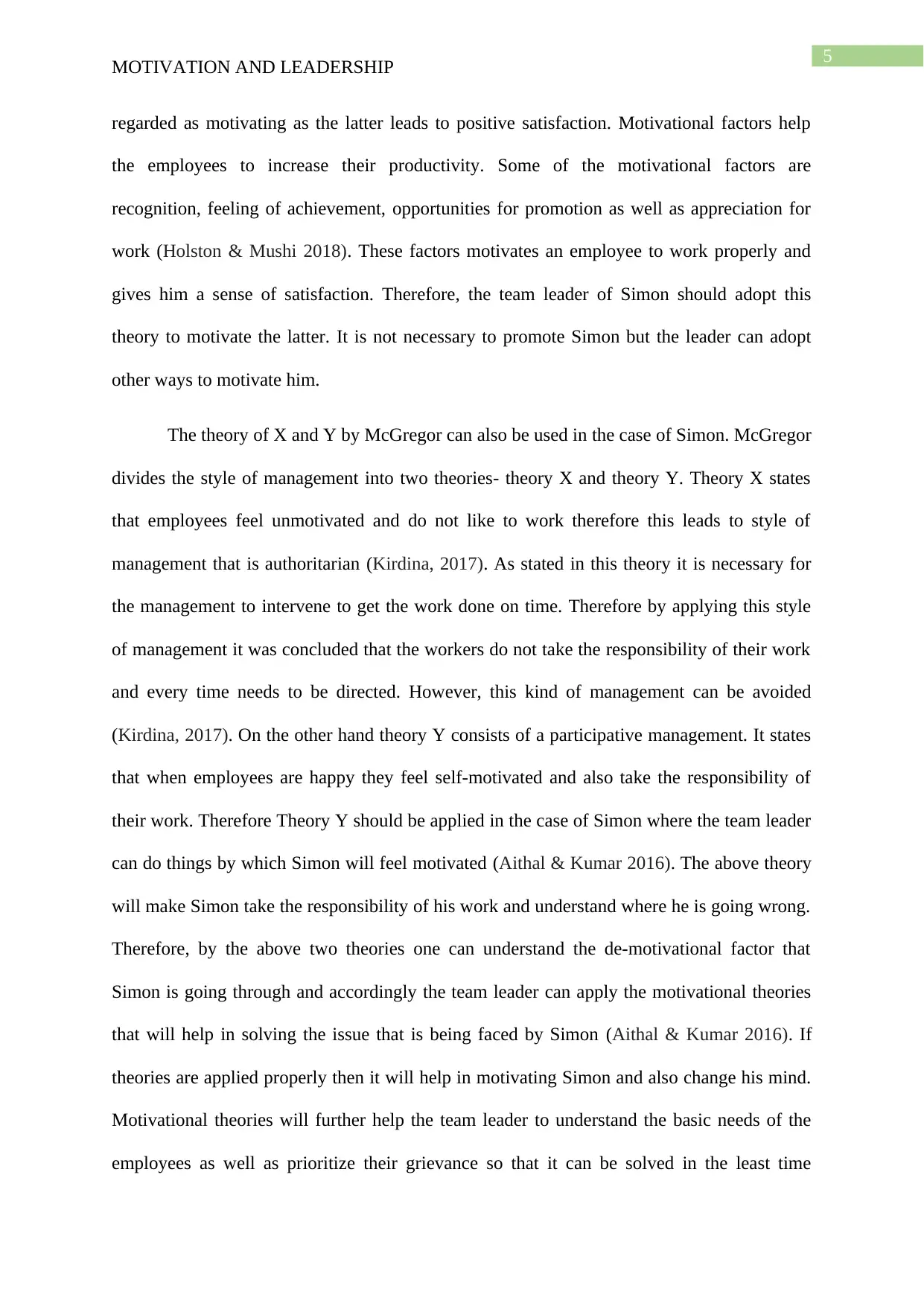
5
MOTIVATION AND LEADERSHIP
regarded as motivating as the latter leads to positive satisfaction. Motivational factors help
the employees to increase their productivity. Some of the motivational factors are
recognition, feeling of achievement, opportunities for promotion as well as appreciation for
work (Holston & Mushi 2018). These factors motivates an employee to work properly and
gives him a sense of satisfaction. Therefore, the team leader of Simon should adopt this
theory to motivate the latter. It is not necessary to promote Simon but the leader can adopt
other ways to motivate him.
The theory of X and Y by McGregor can also be used in the case of Simon. McGregor
divides the style of management into two theories- theory X and theory Y. Theory X states
that employees feel unmotivated and do not like to work therefore this leads to style of
management that is authoritarian (Kirdina, 2017). As stated in this theory it is necessary for
the management to intervene to get the work done on time. Therefore by applying this style
of management it was concluded that the workers do not take the responsibility of their work
and every time needs to be directed. However, this kind of management can be avoided
(Kirdina, 2017). On the other hand theory Y consists of a participative management. It states
that when employees are happy they feel self-motivated and also take the responsibility of
their work. Therefore Theory Y should be applied in the case of Simon where the team leader
can do things by which Simon will feel motivated (Aithal & Kumar 2016). The above theory
will make Simon take the responsibility of his work and understand where he is going wrong.
Therefore, by the above two theories one can understand the de-motivational factor that
Simon is going through and accordingly the team leader can apply the motivational theories
that will help in solving the issue that is being faced by Simon (Aithal & Kumar 2016). If
theories are applied properly then it will help in motivating Simon and also change his mind.
Motivational theories will further help the team leader to understand the basic needs of the
employees as well as prioritize their grievance so that it can be solved in the least time
MOTIVATION AND LEADERSHIP
regarded as motivating as the latter leads to positive satisfaction. Motivational factors help
the employees to increase their productivity. Some of the motivational factors are
recognition, feeling of achievement, opportunities for promotion as well as appreciation for
work (Holston & Mushi 2018). These factors motivates an employee to work properly and
gives him a sense of satisfaction. Therefore, the team leader of Simon should adopt this
theory to motivate the latter. It is not necessary to promote Simon but the leader can adopt
other ways to motivate him.
The theory of X and Y by McGregor can also be used in the case of Simon. McGregor
divides the style of management into two theories- theory X and theory Y. Theory X states
that employees feel unmotivated and do not like to work therefore this leads to style of
management that is authoritarian (Kirdina, 2017). As stated in this theory it is necessary for
the management to intervene to get the work done on time. Therefore by applying this style
of management it was concluded that the workers do not take the responsibility of their work
and every time needs to be directed. However, this kind of management can be avoided
(Kirdina, 2017). On the other hand theory Y consists of a participative management. It states
that when employees are happy they feel self-motivated and also take the responsibility of
their work. Therefore Theory Y should be applied in the case of Simon where the team leader
can do things by which Simon will feel motivated (Aithal & Kumar 2016). The above theory
will make Simon take the responsibility of his work and understand where he is going wrong.
Therefore, by the above two theories one can understand the de-motivational factor that
Simon is going through and accordingly the team leader can apply the motivational theories
that will help in solving the issue that is being faced by Simon (Aithal & Kumar 2016). If
theories are applied properly then it will help in motivating Simon and also change his mind.
Motivational theories will further help the team leader to understand the basic needs of the
employees as well as prioritize their grievance so that it can be solved in the least time
⊘ This is a preview!⊘
Do you want full access?
Subscribe today to unlock all pages.

Trusted by 1+ million students worldwide
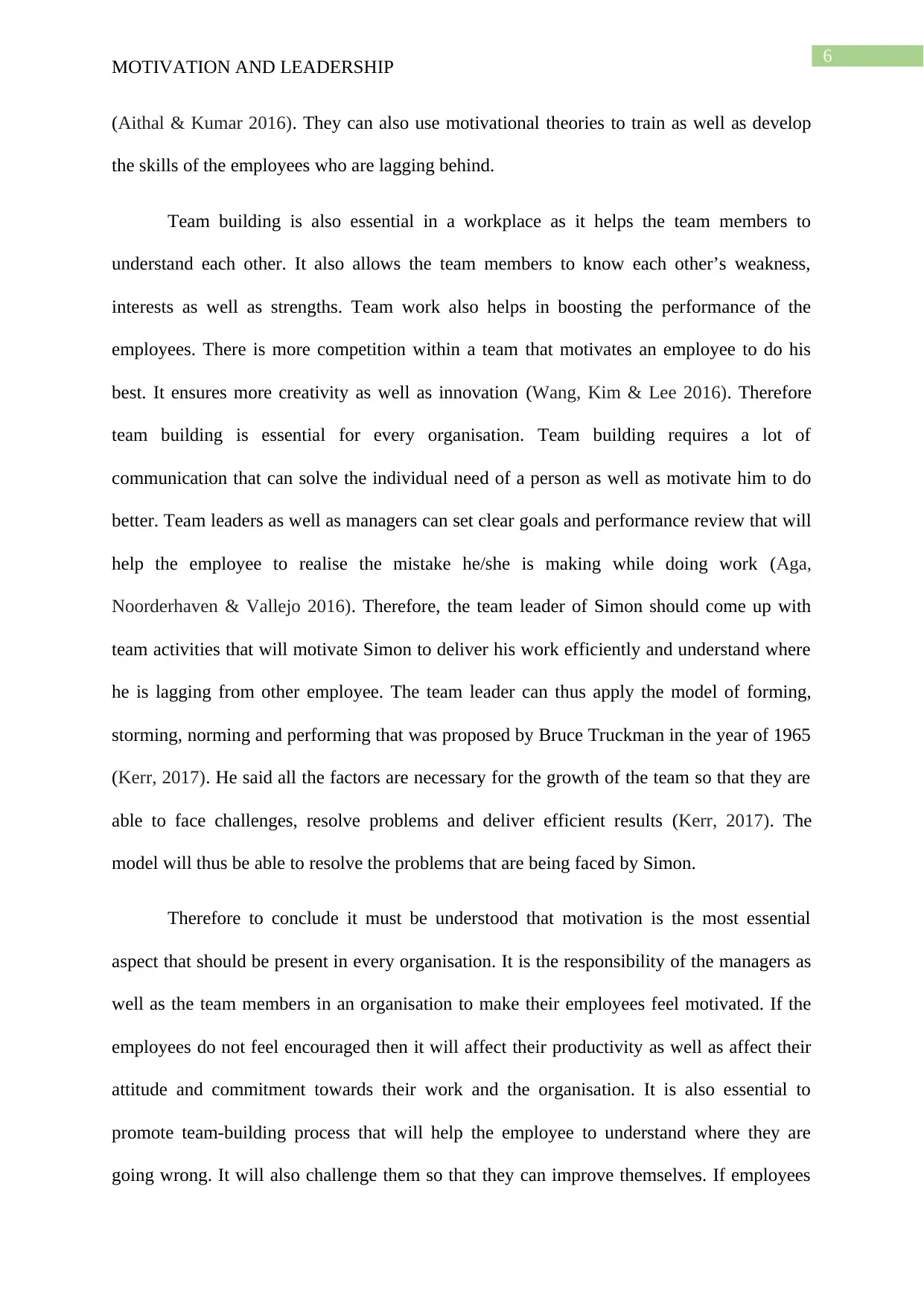
6
MOTIVATION AND LEADERSHIP
(Aithal & Kumar 2016). They can also use motivational theories to train as well as develop
the skills of the employees who are lagging behind.
Team building is also essential in a workplace as it helps the team members to
understand each other. It also allows the team members to know each other’s weakness,
interests as well as strengths. Team work also helps in boosting the performance of the
employees. There is more competition within a team that motivates an employee to do his
best. It ensures more creativity as well as innovation (Wang, Kim & Lee 2016). Therefore
team building is essential for every organisation. Team building requires a lot of
communication that can solve the individual need of a person as well as motivate him to do
better. Team leaders as well as managers can set clear goals and performance review that will
help the employee to realise the mistake he/she is making while doing work (Aga,
Noorderhaven & Vallejo 2016). Therefore, the team leader of Simon should come up with
team activities that will motivate Simon to deliver his work efficiently and understand where
he is lagging from other employee. The team leader can thus apply the model of forming,
storming, norming and performing that was proposed by Bruce Truckman in the year of 1965
(Kerr, 2017). He said all the factors are necessary for the growth of the team so that they are
able to face challenges, resolve problems and deliver efficient results (Kerr, 2017). The
model will thus be able to resolve the problems that are being faced by Simon.
Therefore to conclude it must be understood that motivation is the most essential
aspect that should be present in every organisation. It is the responsibility of the managers as
well as the team members in an organisation to make their employees feel motivated. If the
employees do not feel encouraged then it will affect their productivity as well as affect their
attitude and commitment towards their work and the organisation. It is also essential to
promote team-building process that will help the employee to understand where they are
going wrong. It will also challenge them so that they can improve themselves. If employees
MOTIVATION AND LEADERSHIP
(Aithal & Kumar 2016). They can also use motivational theories to train as well as develop
the skills of the employees who are lagging behind.
Team building is also essential in a workplace as it helps the team members to
understand each other. It also allows the team members to know each other’s weakness,
interests as well as strengths. Team work also helps in boosting the performance of the
employees. There is more competition within a team that motivates an employee to do his
best. It ensures more creativity as well as innovation (Wang, Kim & Lee 2016). Therefore
team building is essential for every organisation. Team building requires a lot of
communication that can solve the individual need of a person as well as motivate him to do
better. Team leaders as well as managers can set clear goals and performance review that will
help the employee to realise the mistake he/she is making while doing work (Aga,
Noorderhaven & Vallejo 2016). Therefore, the team leader of Simon should come up with
team activities that will motivate Simon to deliver his work efficiently and understand where
he is lagging from other employee. The team leader can thus apply the model of forming,
storming, norming and performing that was proposed by Bruce Truckman in the year of 1965
(Kerr, 2017). He said all the factors are necessary for the growth of the team so that they are
able to face challenges, resolve problems and deliver efficient results (Kerr, 2017). The
model will thus be able to resolve the problems that are being faced by Simon.
Therefore to conclude it must be understood that motivation is the most essential
aspect that should be present in every organisation. It is the responsibility of the managers as
well as the team members in an organisation to make their employees feel motivated. If the
employees do not feel encouraged then it will affect their productivity as well as affect their
attitude and commitment towards their work and the organisation. It is also essential to
promote team-building process that will help the employee to understand where they are
going wrong. It will also challenge them so that they can improve themselves. If employees
Paraphrase This Document
Need a fresh take? Get an instant paraphrase of this document with our AI Paraphraser
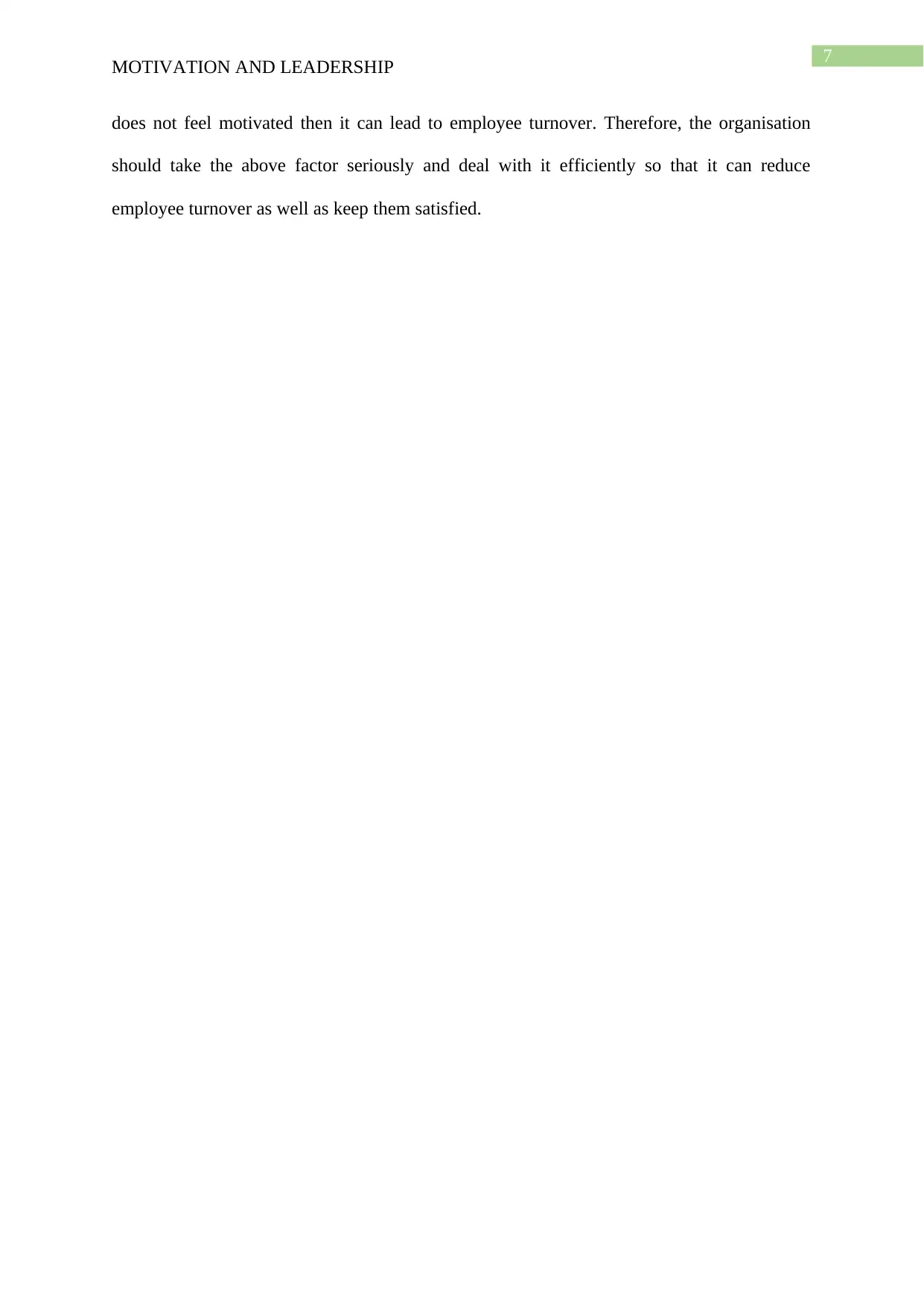
7
MOTIVATION AND LEADERSHIP
does not feel motivated then it can lead to employee turnover. Therefore, the organisation
should take the above factor seriously and deal with it efficiently so that it can reduce
employee turnover as well as keep them satisfied.
MOTIVATION AND LEADERSHIP
does not feel motivated then it can lead to employee turnover. Therefore, the organisation
should take the above factor seriously and deal with it efficiently so that it can reduce
employee turnover as well as keep them satisfied.
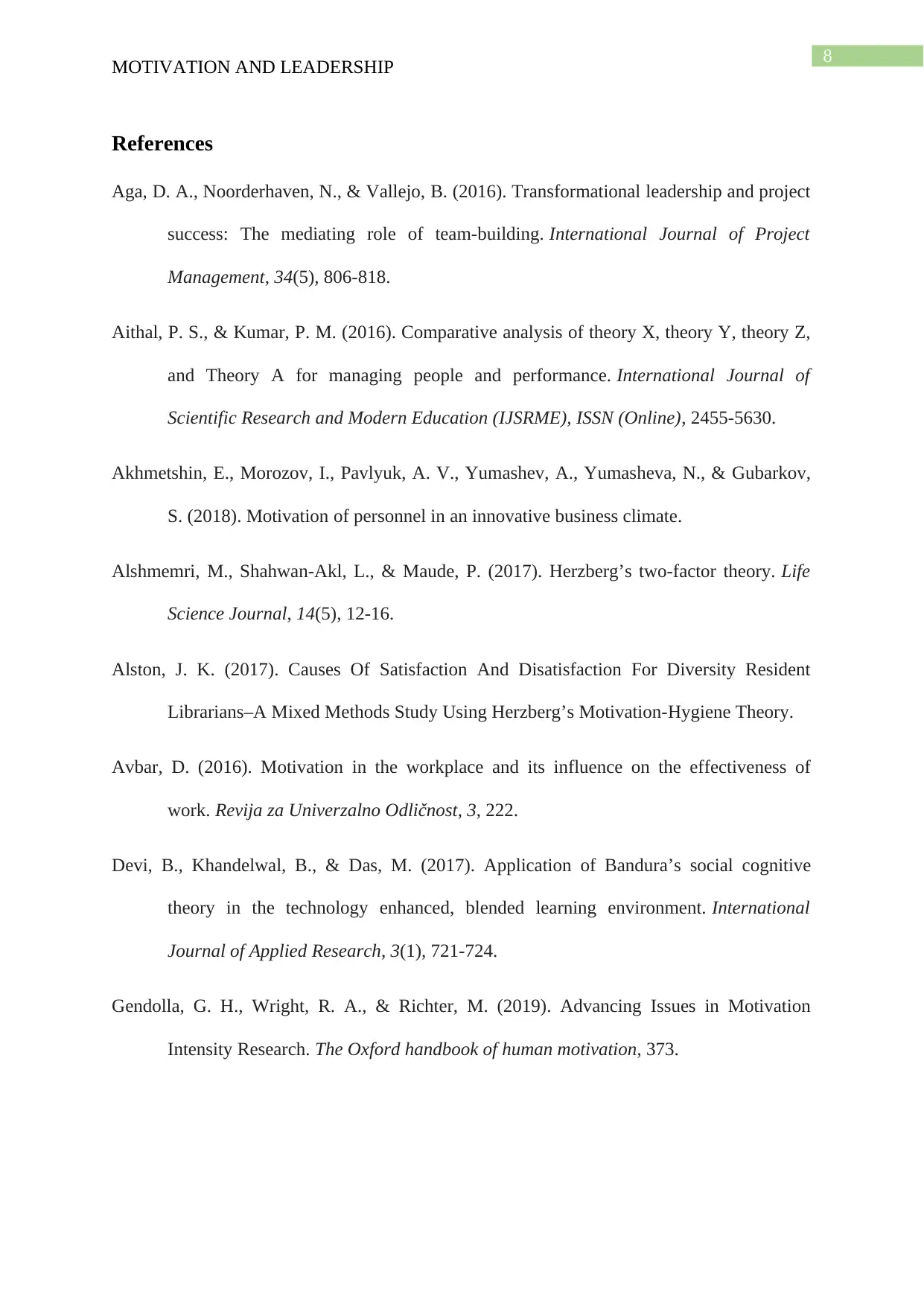
8
MOTIVATION AND LEADERSHIP
References
Aga, D. A., Noorderhaven, N., & Vallejo, B. (2016). Transformational leadership and project
success: The mediating role of team-building. International Journal of Project
Management, 34(5), 806-818.
Aithal, P. S., & Kumar, P. M. (2016). Comparative analysis of theory X, theory Y, theory Z,
and Theory A for managing people and performance. International Journal of
Scientific Research and Modern Education (IJSRME), ISSN (Online), 2455-5630.
Akhmetshin, E., Morozov, I., Pavlyuk, A. V., Yumashev, A., Yumasheva, N., & Gubarkov,
S. (2018). Motivation of personnel in an innovative business climate.
Alshmemri, M., Shahwan-Akl, L., & Maude, P. (2017). Herzberg’s two-factor theory. Life
Science Journal, 14(5), 12-16.
Alston, J. K. (2017). Causes Of Satisfaction And Disatisfaction For Diversity Resident
Librarians–A Mixed Methods Study Using Herzberg’s Motivation-Hygiene Theory.
Avbar, D. (2016). Motivation in the workplace and its influence on the effectiveness of
work. Revija za Univerzalno Odličnost, 3, 222.
Devi, B., Khandelwal, B., & Das, M. (2017). Application of Bandura’s social cognitive
theory in the technology enhanced, blended learning environment. International
Journal of Applied Research, 3(1), 721-724.
Gendolla, G. H., Wright, R. A., & Richter, M. (2019). Advancing Issues in Motivation
Intensity Research. The Oxford handbook of human motivation, 373.
MOTIVATION AND LEADERSHIP
References
Aga, D. A., Noorderhaven, N., & Vallejo, B. (2016). Transformational leadership and project
success: The mediating role of team-building. International Journal of Project
Management, 34(5), 806-818.
Aithal, P. S., & Kumar, P. M. (2016). Comparative analysis of theory X, theory Y, theory Z,
and Theory A for managing people and performance. International Journal of
Scientific Research and Modern Education (IJSRME), ISSN (Online), 2455-5630.
Akhmetshin, E., Morozov, I., Pavlyuk, A. V., Yumashev, A., Yumasheva, N., & Gubarkov,
S. (2018). Motivation of personnel in an innovative business climate.
Alshmemri, M., Shahwan-Akl, L., & Maude, P. (2017). Herzberg’s two-factor theory. Life
Science Journal, 14(5), 12-16.
Alston, J. K. (2017). Causes Of Satisfaction And Disatisfaction For Diversity Resident
Librarians–A Mixed Methods Study Using Herzberg’s Motivation-Hygiene Theory.
Avbar, D. (2016). Motivation in the workplace and its influence on the effectiveness of
work. Revija za Univerzalno Odličnost, 3, 222.
Devi, B., Khandelwal, B., & Das, M. (2017). Application of Bandura’s social cognitive
theory in the technology enhanced, blended learning environment. International
Journal of Applied Research, 3(1), 721-724.
Gendolla, G. H., Wright, R. A., & Richter, M. (2019). Advancing Issues in Motivation
Intensity Research. The Oxford handbook of human motivation, 373.
⊘ This is a preview!⊘
Do you want full access?
Subscribe today to unlock all pages.

Trusted by 1+ million students worldwide
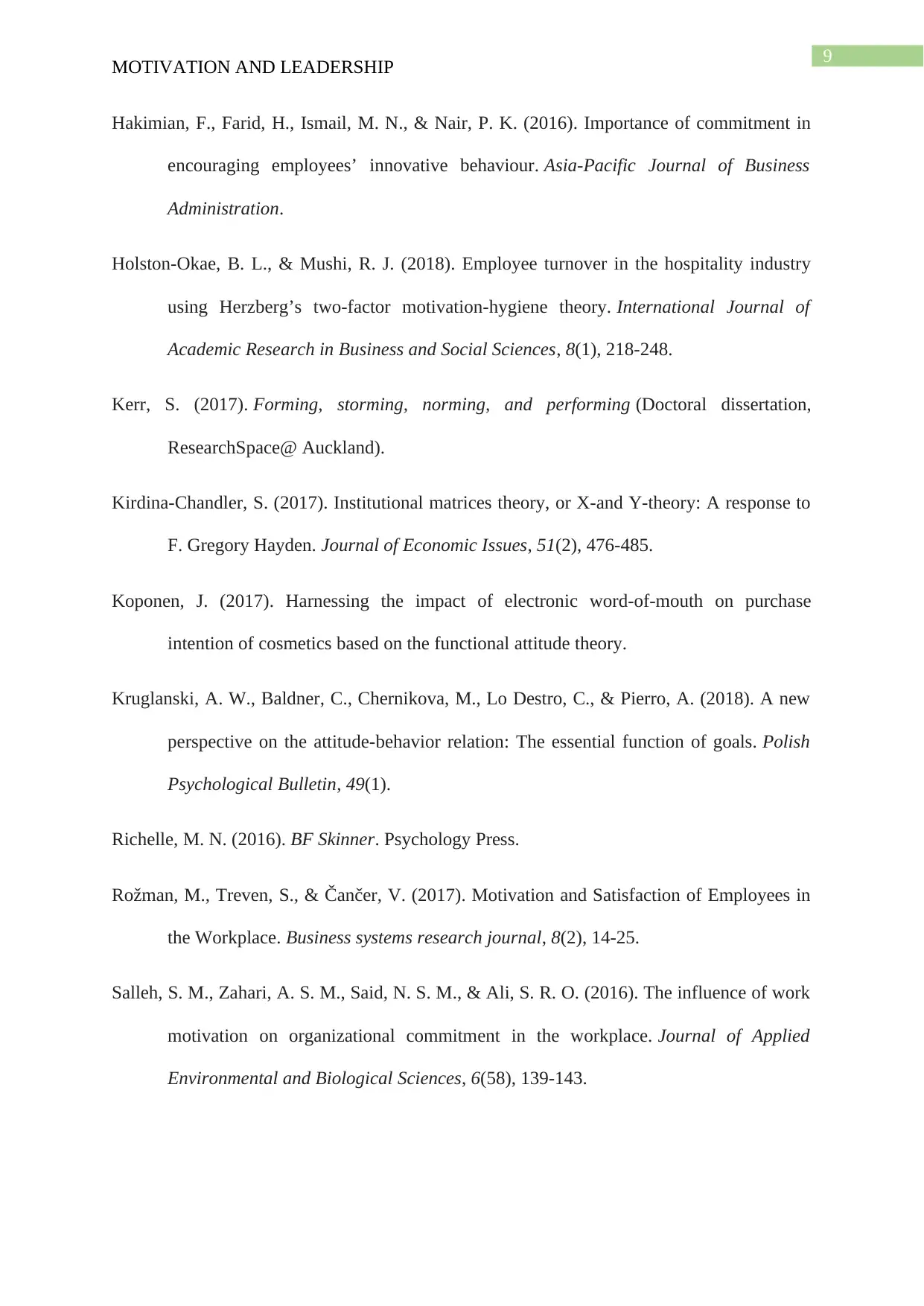
9
MOTIVATION AND LEADERSHIP
Hakimian, F., Farid, H., Ismail, M. N., & Nair, P. K. (2016). Importance of commitment in
encouraging employees’ innovative behaviour. Asia-Pacific Journal of Business
Administration.
Holston-Okae, B. L., & Mushi, R. J. (2018). Employee turnover in the hospitality industry
using Herzberg’s two-factor motivation-hygiene theory. International Journal of
Academic Research in Business and Social Sciences, 8(1), 218-248.
Kerr, S. (2017). Forming, storming, norming, and performing (Doctoral dissertation,
ResearchSpace@ Auckland).
Kirdina-Chandler, S. (2017). Institutional matrices theory, or X-and Y-theory: A response to
F. Gregory Hayden. Journal of Economic Issues, 51(2), 476-485.
Koponen, J. (2017). Harnessing the impact of electronic word-of-mouth on purchase
intention of cosmetics based on the functional attitude theory.
Kruglanski, A. W., Baldner, C., Chernikova, M., Lo Destro, C., & Pierro, A. (2018). A new
perspective on the attitude-behavior relation: The essential function of goals. Polish
Psychological Bulletin, 49(1).
Richelle, M. N. (2016). BF Skinner. Psychology Press.
Rožman, M., Treven, S., & Čančer, V. (2017). Motivation and Satisfaction of Employees in
the Workplace. Business systems research journal, 8(2), 14-25.
Salleh, S. M., Zahari, A. S. M., Said, N. S. M., & Ali, S. R. O. (2016). The influence of work
motivation on organizational commitment in the workplace. Journal of Applied
Environmental and Biological Sciences, 6(58), 139-143.
MOTIVATION AND LEADERSHIP
Hakimian, F., Farid, H., Ismail, M. N., & Nair, P. K. (2016). Importance of commitment in
encouraging employees’ innovative behaviour. Asia-Pacific Journal of Business
Administration.
Holston-Okae, B. L., & Mushi, R. J. (2018). Employee turnover in the hospitality industry
using Herzberg’s two-factor motivation-hygiene theory. International Journal of
Academic Research in Business and Social Sciences, 8(1), 218-248.
Kerr, S. (2017). Forming, storming, norming, and performing (Doctoral dissertation,
ResearchSpace@ Auckland).
Kirdina-Chandler, S. (2017). Institutional matrices theory, or X-and Y-theory: A response to
F. Gregory Hayden. Journal of Economic Issues, 51(2), 476-485.
Koponen, J. (2017). Harnessing the impact of electronic word-of-mouth on purchase
intention of cosmetics based on the functional attitude theory.
Kruglanski, A. W., Baldner, C., Chernikova, M., Lo Destro, C., & Pierro, A. (2018). A new
perspective on the attitude-behavior relation: The essential function of goals. Polish
Psychological Bulletin, 49(1).
Richelle, M. N. (2016). BF Skinner. Psychology Press.
Rožman, M., Treven, S., & Čančer, V. (2017). Motivation and Satisfaction of Employees in
the Workplace. Business systems research journal, 8(2), 14-25.
Salleh, S. M., Zahari, A. S. M., Said, N. S. M., & Ali, S. R. O. (2016). The influence of work
motivation on organizational commitment in the workplace. Journal of Applied
Environmental and Biological Sciences, 6(58), 139-143.
Paraphrase This Document
Need a fresh take? Get an instant paraphrase of this document with our AI Paraphraser
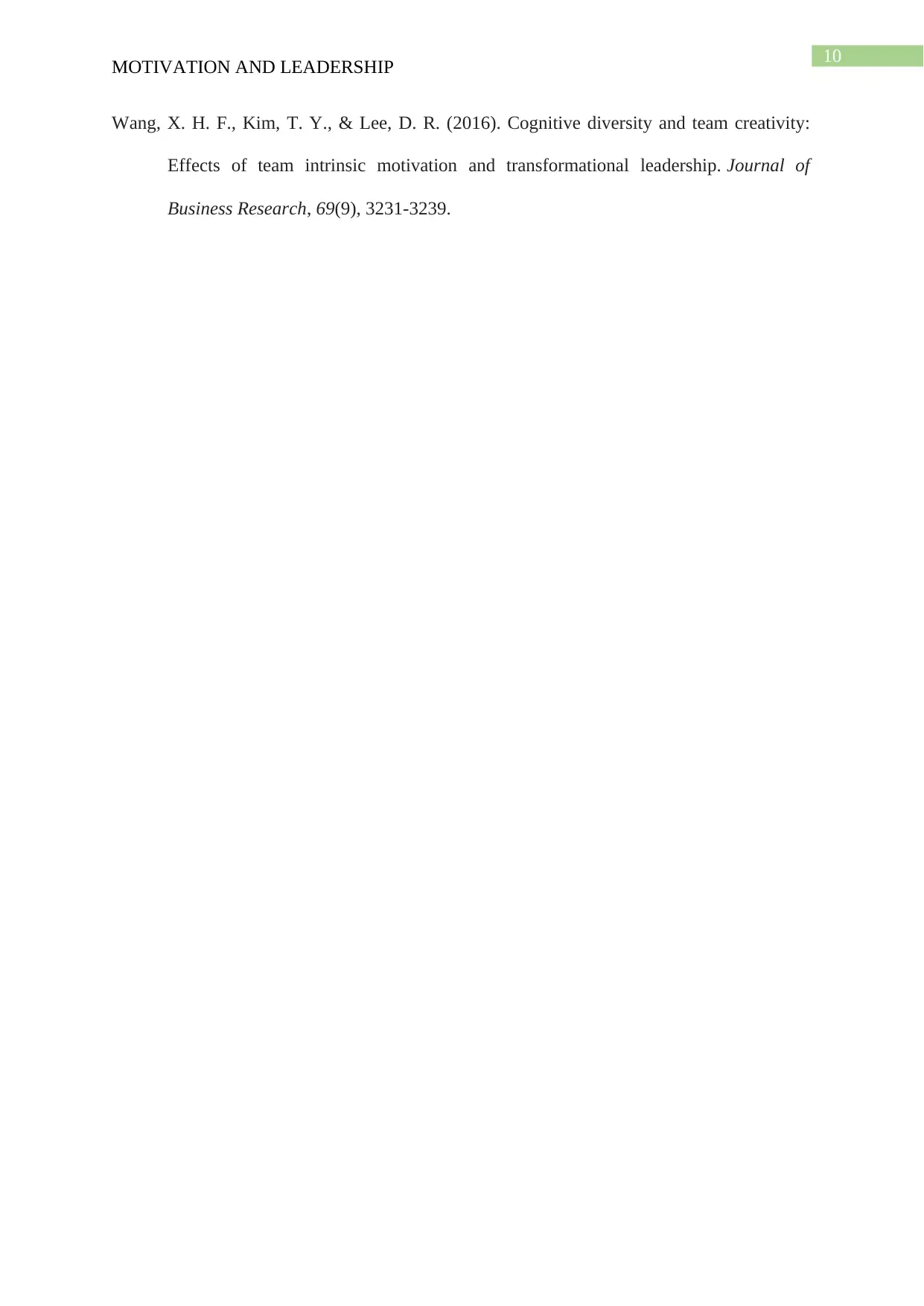
10
MOTIVATION AND LEADERSHIP
Wang, X. H. F., Kim, T. Y., & Lee, D. R. (2016). Cognitive diversity and team creativity:
Effects of team intrinsic motivation and transformational leadership. Journal of
Business Research, 69(9), 3231-3239.
MOTIVATION AND LEADERSHIP
Wang, X. H. F., Kim, T. Y., & Lee, D. R. (2016). Cognitive diversity and team creativity:
Effects of team intrinsic motivation and transformational leadership. Journal of
Business Research, 69(9), 3231-3239.
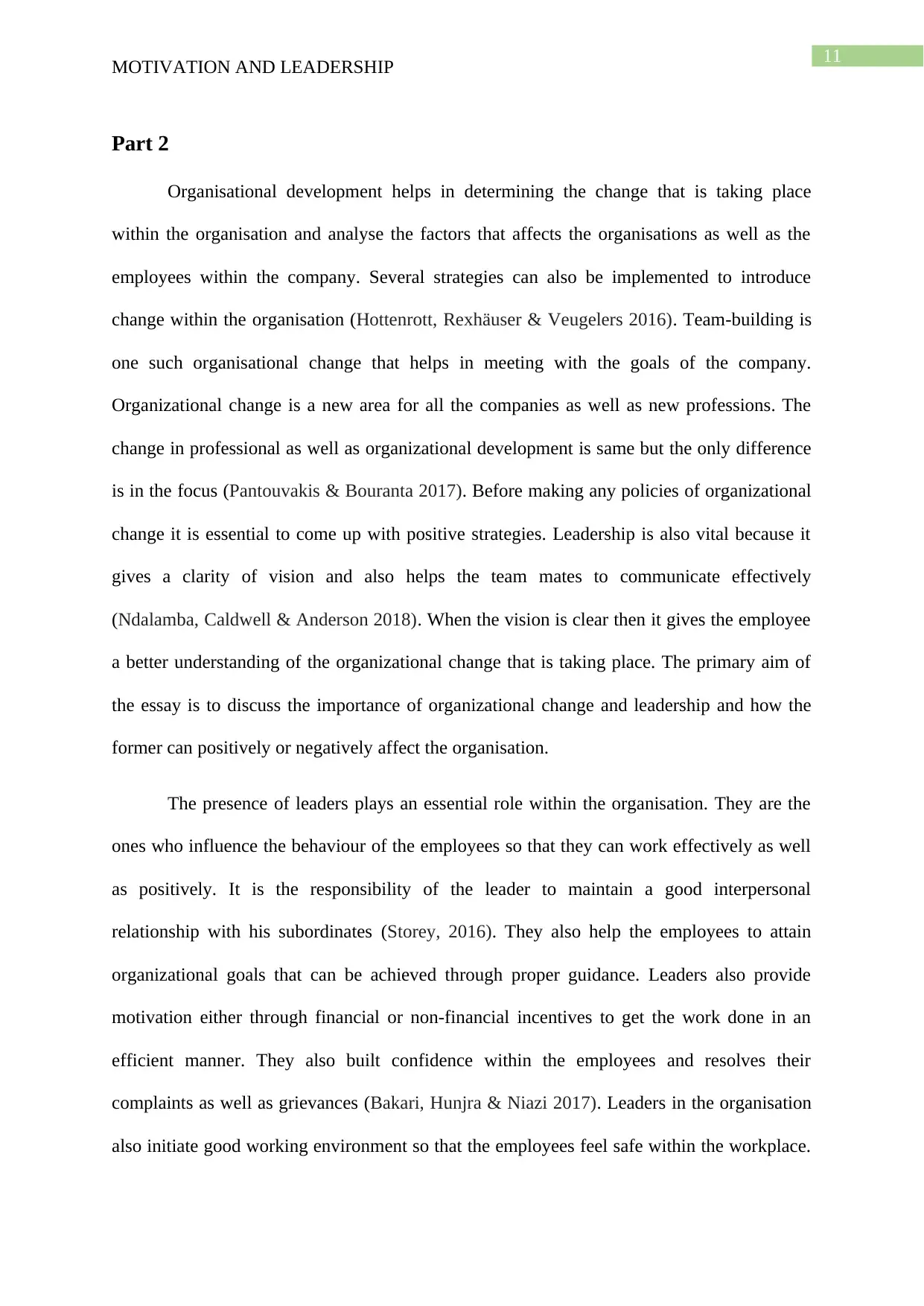
11
MOTIVATION AND LEADERSHIP
Part 2
Organisational development helps in determining the change that is taking place
within the organisation and analyse the factors that affects the organisations as well as the
employees within the company. Several strategies can also be implemented to introduce
change within the organisation (Hottenrott, Rexhäuser & Veugelers 2016). Team-building is
one such organisational change that helps in meeting with the goals of the company.
Organizational change is a new area for all the companies as well as new professions. The
change in professional as well as organizational development is same but the only difference
is in the focus (Pantouvakis & Bouranta 2017). Before making any policies of organizational
change it is essential to come up with positive strategies. Leadership is also vital because it
gives a clarity of vision and also helps the team mates to communicate effectively
(Ndalamba, Caldwell & Anderson 2018). When the vision is clear then it gives the employee
a better understanding of the organizational change that is taking place. The primary aim of
the essay is to discuss the importance of organizational change and leadership and how the
former can positively or negatively affect the organisation.
The presence of leaders plays an essential role within the organisation. They are the
ones who influence the behaviour of the employees so that they can work effectively as well
as positively. It is the responsibility of the leader to maintain a good interpersonal
relationship with his subordinates (Storey, 2016). They also help the employees to attain
organizational goals that can be achieved through proper guidance. Leaders also provide
motivation either through financial or non-financial incentives to get the work done in an
efficient manner. They also built confidence within the employees and resolves their
complaints as well as grievances (Bakari, Hunjra & Niazi 2017). Leaders in the organisation
also initiate good working environment so that the employees feel safe within the workplace.
MOTIVATION AND LEADERSHIP
Part 2
Organisational development helps in determining the change that is taking place
within the organisation and analyse the factors that affects the organisations as well as the
employees within the company. Several strategies can also be implemented to introduce
change within the organisation (Hottenrott, Rexhäuser & Veugelers 2016). Team-building is
one such organisational change that helps in meeting with the goals of the company.
Organizational change is a new area for all the companies as well as new professions. The
change in professional as well as organizational development is same but the only difference
is in the focus (Pantouvakis & Bouranta 2017). Before making any policies of organizational
change it is essential to come up with positive strategies. Leadership is also vital because it
gives a clarity of vision and also helps the team mates to communicate effectively
(Ndalamba, Caldwell & Anderson 2018). When the vision is clear then it gives the employee
a better understanding of the organizational change that is taking place. The primary aim of
the essay is to discuss the importance of organizational change and leadership and how the
former can positively or negatively affect the organisation.
The presence of leaders plays an essential role within the organisation. They are the
ones who influence the behaviour of the employees so that they can work effectively as well
as positively. It is the responsibility of the leader to maintain a good interpersonal
relationship with his subordinates (Storey, 2016). They also help the employees to attain
organizational goals that can be achieved through proper guidance. Leaders also provide
motivation either through financial or non-financial incentives to get the work done in an
efficient manner. They also built confidence within the employees and resolves their
complaints as well as grievances (Bakari, Hunjra & Niazi 2017). Leaders in the organisation
also initiate good working environment so that the employees feel safe within the workplace.
⊘ This is a preview!⊘
Do you want full access?
Subscribe today to unlock all pages.

Trusted by 1+ million students worldwide
1 out of 21
Related Documents
Your All-in-One AI-Powered Toolkit for Academic Success.
+13062052269
info@desklib.com
Available 24*7 on WhatsApp / Email
![[object Object]](/_next/static/media/star-bottom.7253800d.svg)
Unlock your academic potential
Copyright © 2020–2025 A2Z Services. All Rights Reserved. Developed and managed by ZUCOL.





